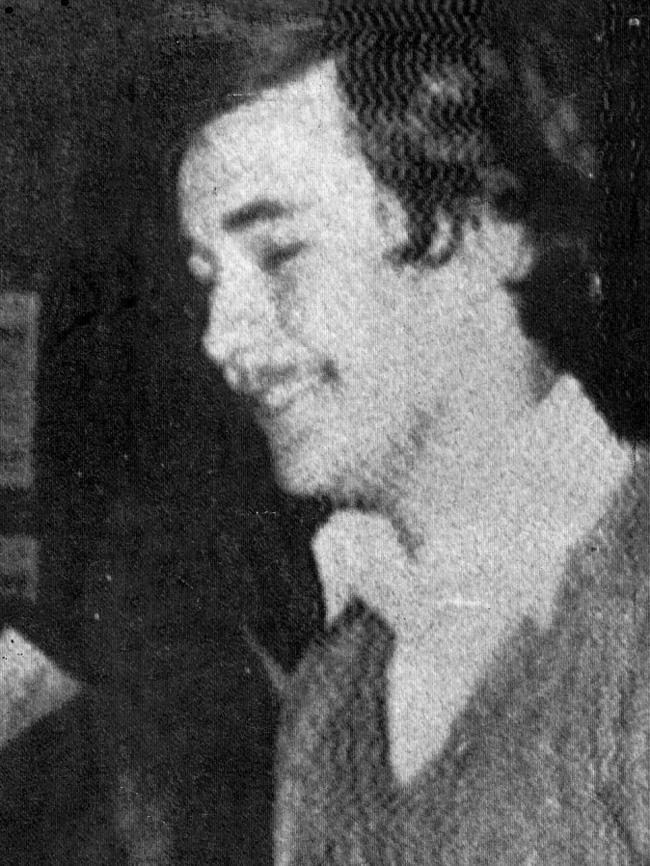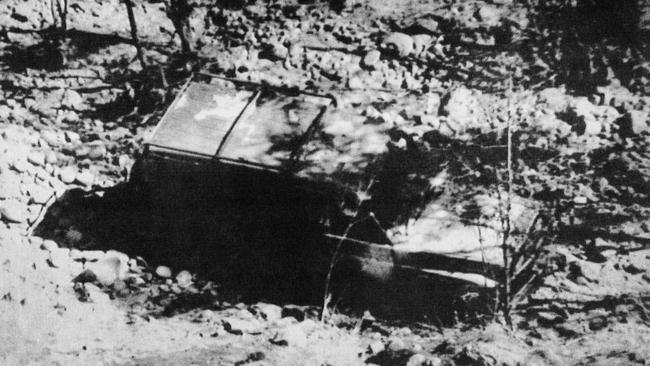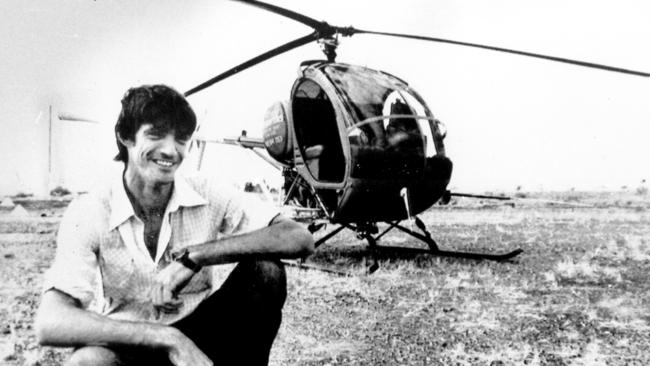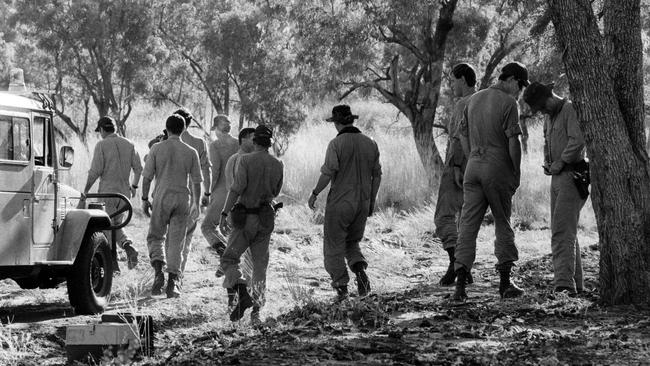THE early dry season in the Top End is prime time for fishing enthusiasts who head north to try to catch the plentiful barramundi in the region’s countless waterways.
In June 1987, retired Fremantle councillor Marcus Bullen, 70, his wife Winifred, their son Lance, 42, and his wife Joan were travelling back home to Perth after a leisurely sojourn in the NT and Kimberley.
Backpacker murders: Did Ivan Milat have an accomplice?
Ivan Milat: The day they discovered the first of his victims
The foursome had set up camp at Timber Creek township when the men set off to the nearby Victoria River to scout potential campsites for a spot of barra fishing.
The men drove off on the morning of June 9, intending to be away just an hour or so.
They were never seen alive again.

Marcus and Lance Bullen were reported missing by their worried wives late in the afternoon of June 9. Police reassured the women the men had probably broken down on one of the bush tracks near the Victoria River and would probably turn up safe and sound the next day.
Instead, police found their burnt out Mitsubishi Sigma wagon and two shallow graves at the high water mark of the river about 10km from Timber Creek.
Both men had been shot in the back with a high-powered rifle and stripped naked.
Police investigations revealed that the men had been ambushed as they got out of the car, made to lie on their stomachs and shot in cold blood.
Their killer, or killers, had stripped their bodies and dragged them to the high water mark of the river, presumably in the hope crocodiles would destroy the evidence.
The mens’ car was driven a short distance from the site of their execution and set alight.
When the gruesome discovery was made, police scrambled resources to launch one of the biggest manhunts ever undertaken on Australian soil.
Roadblocks were set up around Timber Creek and hundreds of vehicles stopped and searched.
Then, five days after the Bullens were murdered, it happened again.
Air traffic controller Phillip Walkemeyer, 26, his fiancee Julie Warren, 25, and workmate and friend Terry Bolt, 36, were enjoying a weekend away from their jobs in Kununurra, fishing and camping on the Pentecost River, about 300km west of Timber Creek, over the border in Western Australia when they crossed paths with a ruthless killer.
The trio set up camp on June 13 and, along with two other friends, David Mackenzie and Daniel Roe, fished until almost midnight. The next morning, Mackenzie and Roe left to return to Kununurra while Walkemeyer, Warren and Bolt continued fishing.
Two other fishermen camping nearby - Des Murphy and Branko Mijovic - told police later they saw the men relaxing as Julie Warren packed up camp, around 11.15am.
Murphy and Roe left soon after but before they did they noticed another vehicle parked nearby. A white Toyota 4Runner with red markings on the doors. They did not see anybody with the car.
Around 4pm, a truckie driving the nearby Gibb River Road noticed black smoke billowing from the area. He also saw a white Toyota with red markings turn on to the road from a bush track.
On Monday, June 15, back in Kununurra, there was concern when Walkemeyer, Warren and Bolt failed to turn up at work. None were at home either. David Mackenzie drove back to the Pentecost River that afternoon to look for his friends.

He found Walkemeyer’s burnt out Toyota LandCruiser in a gully not far from their camp and his tinnie still sitting in the water. There was no sign of Walkemeyer, Warren or Bolt.
Fearing the worst, Mackenzie called the police.
Around 4pm, Warren’s naked body was found face down on the riverbank about 500m from the campsite. She had been shot in the back. The next morning the bodies of Walkemeyer and Bolt were discovered at two other sites along the river. Both men had been shot several times in the back.
The modus operandi - shot in the back, bodies stripped, car found burnt out - were the same as the Bullen killings.
But when police found a shoeprint that matched a print at the Bullen murder scene, they knew they were hunting a serial killer although they had no idea who. They did have two clues, however.
The killer was probably driving a white Toyota 4Runner with red markings and he appeared to be heading west.

With five murders already, and people in the remote region at near-panic, NT and WA police mounted one of the biggest manhunts in history. Perth’s Tactical Response Group flew in, and for the next five days the TRG team swept station homesteads, many of which had been abandoned by the terrified occupants.
They also set up ambushes for vehicles on remote dirt roads.
“The roads were virtually empty because word had got out that there was a murderer on the loose,” retired TRG member Bob Brown told The West Australian in 2017.
Then police got lucky.
WATCH TONIGHT: Crime Investigation Australia: The Kimberley Killer airs 8.30pm on Foxtel’s Crime+Investigation channel
On June 19, 1987, Fitzroy River helicopter pilot Peter Lutengemer was mustering wild scrub cattle for the year’s biggest rodeo when he spotted a white Toyota 4WD hidden behind bushes and a tarpaulin at a makeshift bushcamp about 10km outside Fitzroy Crossing.
Lutengemer flew off to alert police.
On the ground, a TRG squad moved in toward the camp.

Suddenly shots rang out. A man had emerged from the white Toyota with a high-powered rifle and was firing at a police aircraft circling overhead.
As a team of seven TRG officers closed in on foot, the aircraft made a low swoop and it was fired on again by the man.
One of the TRG officers later told the inquest into the gunman’s death: “I shouted: ‘Police, stop shooting’.”
“The person levelled the firearm towards the men on my left and fired.
“I told my crew to return fire . . . we were not going to be shot at.”
One officer escaped injury by centimetres when a bullet passed through his shirt during the shoot-out .
The Perth Coroner’s Court heard that a tactical response group constable, whose name was suppressed, felt one round go past his right shoulder.
“I could feel the shock wave pass close by. The round actually passed through the pocket of my right sleeve,” the constable said.

One shot hit the gunman’s hand, forcing him to drop his rifle. But he grabbed another and ran, zig-zagging and crouching behind shrubs for cover, firing as he went.
Tear gas was then fired at the man, but one of the grenades had set grass alight, in turn exploding ammunition lying around the gunman’s vehicle.
Amid the chaos, the gunman was hit as he ran.
Police found the man’s body dressed in army camouflage pants, but naked from the waist up.
Pathologist John Hilton told the Coroners Court later that the man had died from a shot from behind through the heart and also suffered at least two minor wounds, one in the left hand and one in the buttock.
Police found three rifles and a shotgun, which had been bought from a Brisbane gunshop.
Inside the rented Toyota were a toolbox with Walkemeyer written on it, and credit cards in the names of the three Pentecost River victims.
The man who had brought terror to the outback was dead. But who was he?

Josef Schwab was 21 when he emigrated to Australia from Germany in 1981. He lived in Adelaide for a few years, working as a cabinet-maker. A keen marksman since his teens, he joined a local gun club and regularly headed into the bush to shoot wild pigs.
In 1985, he moved back to Germany where he worked as a nightwatchman and undertook combat training in his spare time before suddenly resigning and flying back to Australia in April 1987.
Schwab landed in Brisbane on April 18, and in the next few days defrauded a bank of $5000 using travellers cheques, hired a Toyota 4 Runner from Avis using a fake ID and bought four guns from a shop in Woolloongabba, along with hundreds of rounds of ammunition. The gunshop owner later told The Courier Mail Schwab seemed “entirely normal”.
“If I had had the slightest reason _ and I have been in the business a long time _ to think he was acting suspiciously or was mentally unbalanced I would have contacted police, as I’ve done before.”
After buying his guns and fuelling his car, Schwab then hit the road, heading toward the NT.
He spent some time in Darwin before heading back on the road, shooting buffalo.
Somewhere along the way, as he drove west from Katherine on the Victoria Highway toward the WA border, he went from hunting buffalo to hunting humans.
Back in his hometown of Poecking, in Germany’s Bavarian region, Schwab was seen as a “lone wolf’’, but also an active member of several community groups.
The people who knew him best said he was a hot-headed youth who once threatened a good friend in a bar with a pistol in front of witnesses.
Some of his seedier friends told The Courier Mail not long after the killing rampage that they were sure that he could kill one or two people, but they couldn’t understand how he could have killed so many.
A fellow gang member said he had personally participated in 20 to 30 car thefts with Schwab and at least three house burglaries. Neither was caught or punished for any of these.
“He was always dangerous,’’ the friend said. “He always carried a pistol in his pocket from the time he was 16.’’
Soon after word of Schwab’s death near Fitzroy Crossing, his parents, Josef, a bank employee, and Johanna, a housewife who occasionally worked as a seamstress from her home, left the residence to avoid reporters in a town where residents said “everyone knows everyone else’’.

Before she and her husband went into seclusion, Mrs Schwab spoke with the West German newspaper Bild.
Its reporters, rather than the police or a parish priest from the village’s three Catholic churches, told her that her son was dead and suspected of killing many others.
“Inconceivable,’’ she said of her son’s crimes.
Schwab wrote his mother four postcards from across Australia and often said he was doing fine.
But the clue may have lain in the last postcard he sent, from Darwin only days before he began his spree.
In a chilling prediction, Schwab wrote to his mother: “I am looking forward to something.’’
Would Schwab have killed more people?
Bob Brown had no doubt.
“Whether he was going to go to the Fitzroy rodeo and shoot people we will never know,” he told The West Australian.
“He was mad and you can’t predict what a madman is going to do, apart from the fact that he will kill again.”


The lie that cost underworld figure his life
When Carl Williams lied about Michael Marshall’s involvement in a contract killing, he as good as signed the hotdog salesman’s death warrant.
Lunchtime jewel heist which rocked Sydney’s CBD
In what was considered the biggest jewellery heist of the first half of the 20th century, in 1947 a thief managed to steal jewels worth about $600k today. But his glory was short-lived.